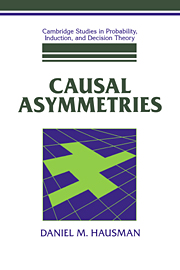Book contents
- Frontmatter
- Contents
- List of Figures
- Acknowledgments
- Introduction: Causation and its Asymmetries
- 1 Metaphysical Pictures and Wishes
- 1* Transfer Theories
- 2 Is Causation a Relation Among Events?
- 3 Causation, Regularities, and Time: Hume's Theory
- 4 Causation and Independence
- 4* Causation, Independence, and Causal Connection
- 5 Agency Theory
- 5* Causal Generalizations and Agency
- 6 The Counterfactual Theory
- 6* Independence and Counterfactual Dependence
- 7 Counterfactuals, Agency, and Independence
- 7* Agency, Counterfactuals, and Independence
- 8 Causation, Explanation, and Laws
- 8* Causation, Explanation, and Independent Alterability
- 9 Probabilistic Causation
- 10 Causation and Conditional Probabilities
- 10* Causal Graphs and Conditional Probabilistic Dependencies
- 11 Intervention, Robustness, and Probabilistic Dependence
- 11* Interventions and Conditional Probabilities
- 12 Operationalizing and Revising the Independence Theory
- 12* Probability Distributions and Causation
- 13 Complications and Conclusions
- Appendix A Alphabetical List of Propositions
- Appendix B List of Theorems
- References
- Index
5 - Agency Theory
Published online by Cambridge University Press: 20 April 2010
- Frontmatter
- Contents
- List of Figures
- Acknowledgments
- Introduction: Causation and its Asymmetries
- 1 Metaphysical Pictures and Wishes
- 1* Transfer Theories
- 2 Is Causation a Relation Among Events?
- 3 Causation, Regularities, and Time: Hume's Theory
- 4 Causation and Independence
- 4* Causation, Independence, and Causal Connection
- 5 Agency Theory
- 5* Causal Generalizations and Agency
- 6 The Counterfactual Theory
- 6* Independence and Counterfactual Dependence
- 7 Counterfactuals, Agency, and Independence
- 7* Agency, Counterfactuals, and Independence
- 8 Causation, Explanation, and Laws
- 8* Causation, Explanation, and Independent Alterability
- 9 Probabilistic Causation
- 10 Causation and Conditional Probabilities
- 10* Causal Graphs and Conditional Probabilistic Dependencies
- 11 Intervention, Robustness, and Probabilistic Dependence
- 11* Interventions and Conditional Probabilities
- 12 Operationalizing and Revising the Independence Theory
- 12* Probability Distributions and Causation
- 13 Complications and Conclusions
- Appendix A Alphabetical List of Propositions
- Appendix B List of Theorems
- References
- Index
Summary
One crucial asymmetry of causation concerns action. Knowing the causes of an event helps one to bring it about. Knowing its effects does not. Knowing what things are related to an event as effects of a common cause does not help one to bring it about either. Causes are means and tools. People can use them to bring about their effects. This observation suggests a theory of causal asymmetry – something like: a causes b if and only if a can be used as a means to bring about b. This view has appealed to scientists and to statisticians. For example, the economist Guy Orcutt writes, “… we see that the statement that … z1 is a cause of z2, is just a convenient way of saying that if you pick an action which controls z1, you will also have an action which controls z2” (1952, p. 307).
Such a theory links the asymmetry of causation to a method of determining which way the causal arrow points: If there is a correlation between a and b and one wants to know what the causal connection is, intervene to find out. a's cause b's just in case human interventions that bring about tokens of kind a lead tokens of kind b to occur as well, while human interventions that bring about b's do not lead to tokens of a occurring. This chapter will be concerned with this theory of causal asymmetry. Following Price and Menzies, I shall call it “the agency theory.” It might also be called “the manipulability theory.”
- Type
- Chapter
- Information
- Causal Asymmetries , pp. 86 - 98Publisher: Cambridge University PressPrint publication year: 1998

